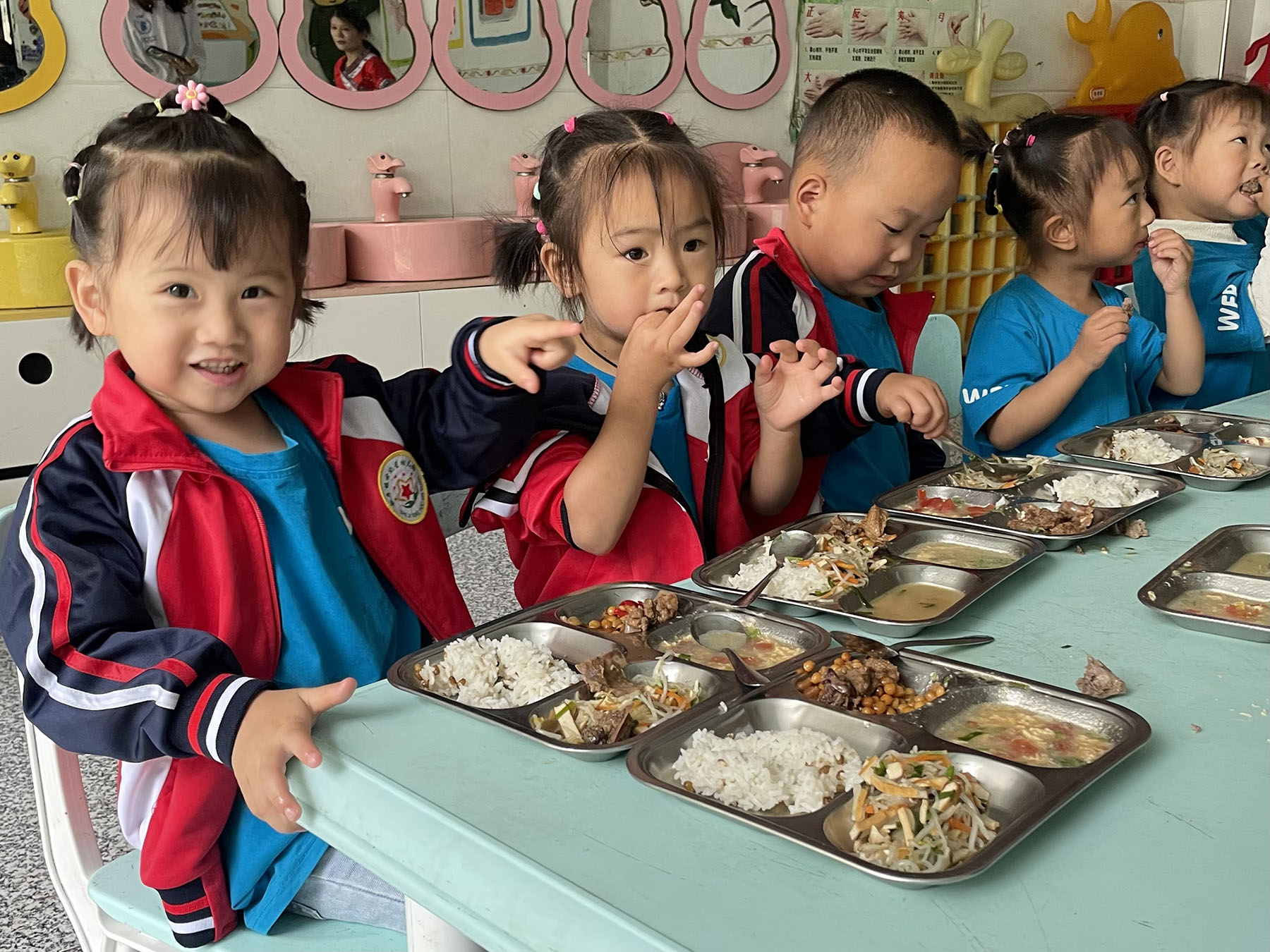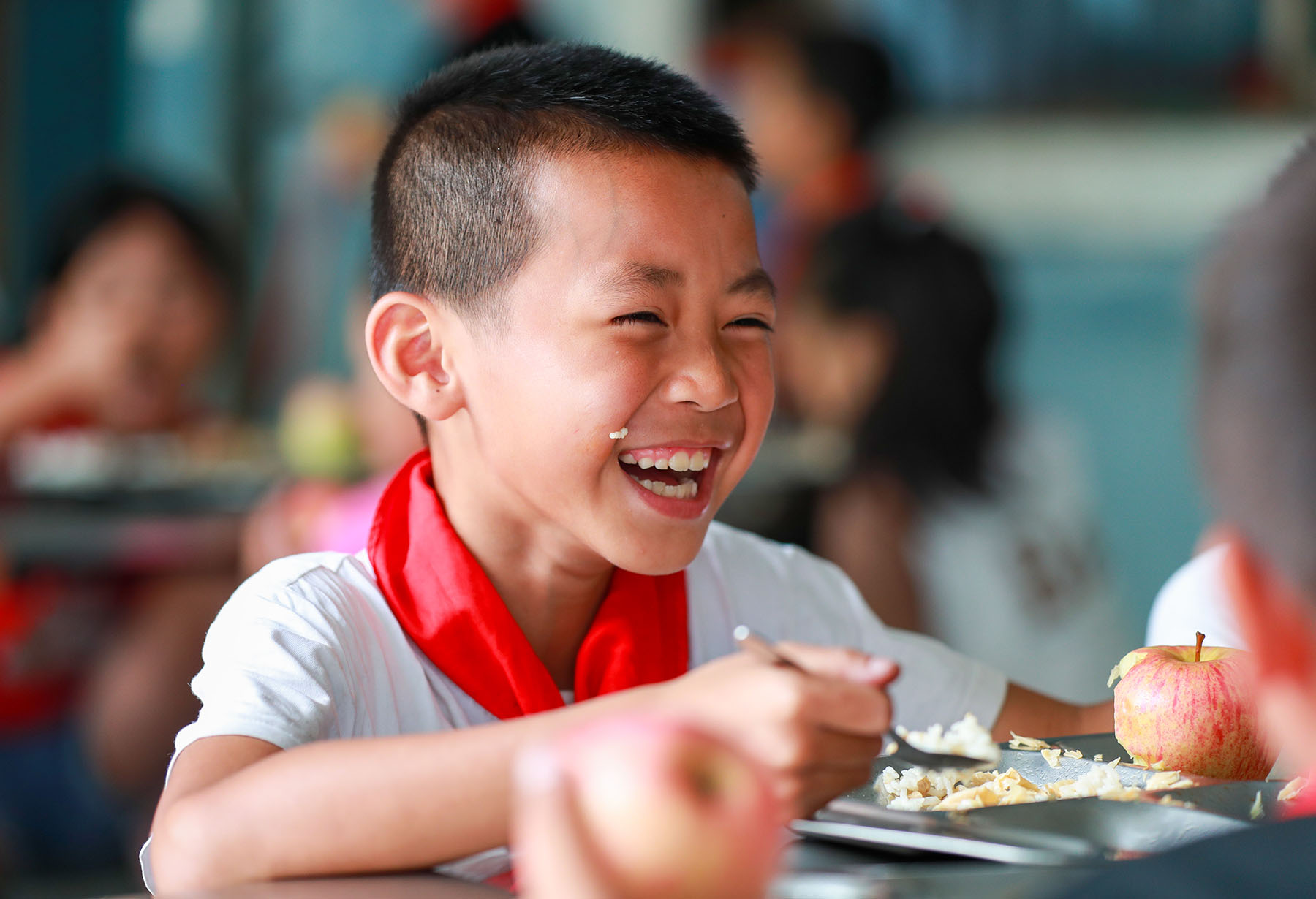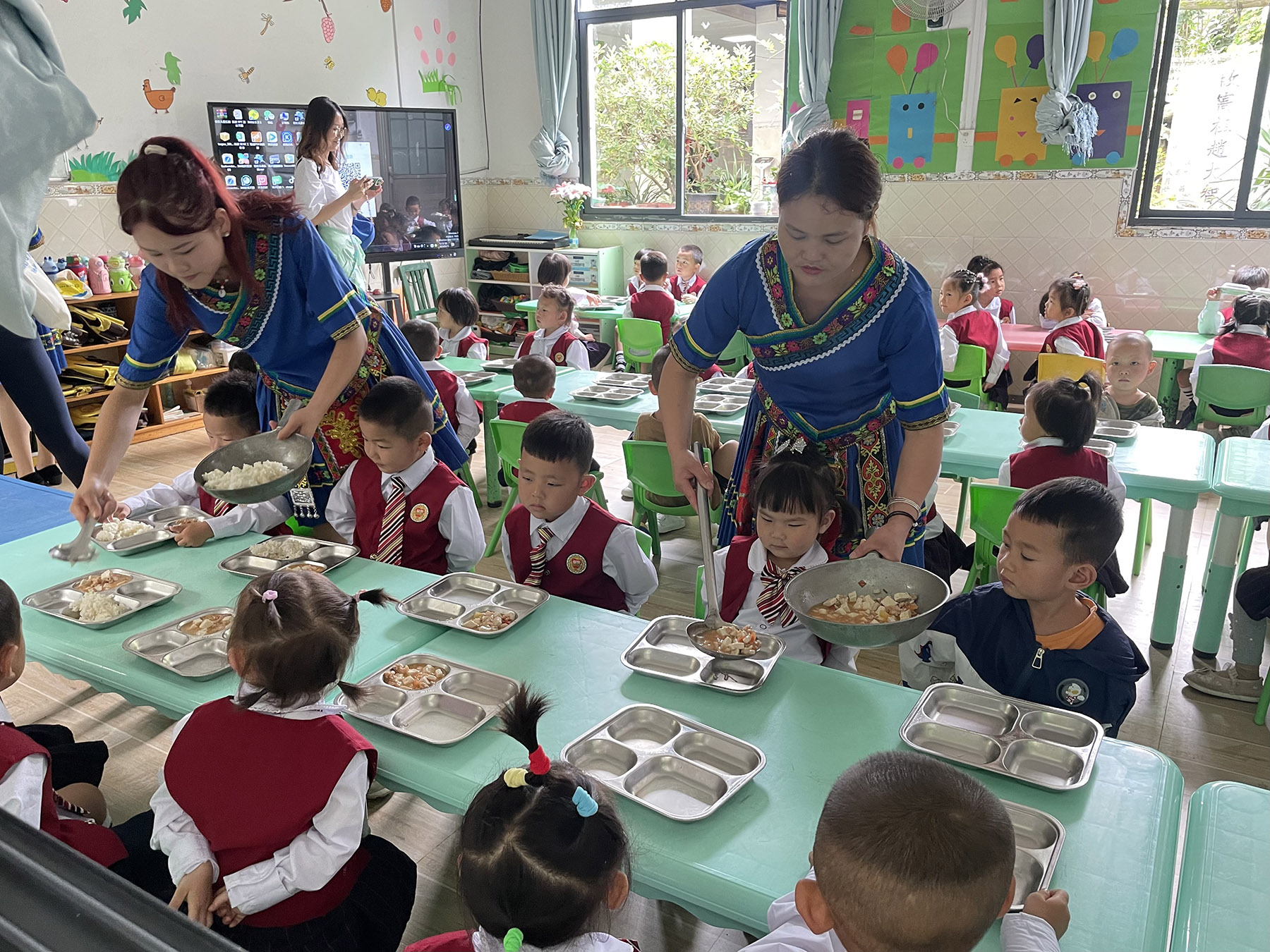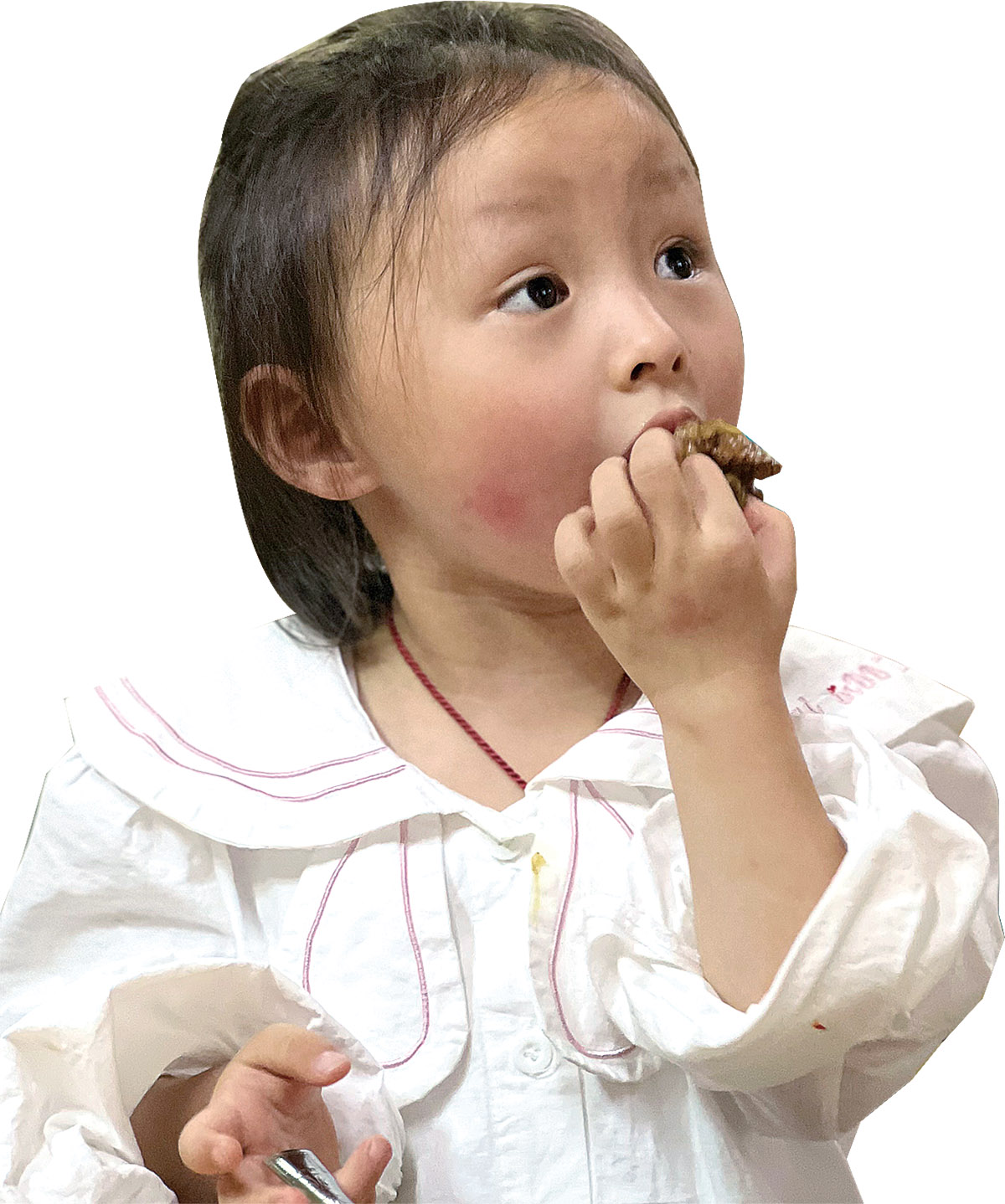Students' growth boosted by school meals that use local produce, help create jobs

At Shaping village kindergarten in a remote area of Central China's Hunan province, a simple meal of pickles and rice was often the only food children received at school. In the past, such a meager children's lunch was not unusual in underdeveloped Yongshun county, nestled in the Xiangxi Tujia and Miao autonomous prefecture.
A two-hour drive along winding mountain roads separates this rural kindergarten from the nearest county hub. Most of its pupils are "left-behind" children, raised by grandparents who often sent them to school on empty stomachs.
Headmaster Peng Nangui recalled the children were often sickly and shorter than the standard height for their age. In flu season, many missed school due to colds and fever.
"Poverty and malnutrition combined cast long shadows over these preschool kids from isolated mountainous regions, severely stunting their growth," said Yi Zungang, director of the prefecture's foreign investment and aid project affairs center.
READ MORE: Falling births trigger calls for reallocating preschool resources
In recent years, the Chinese government has prioritized nutrition for children, launching policies like the "nutrition package" for infants aged 6 to 24 months and the National Nutrition Improvement Program for rural students aged 6 to 15.
However, children aged 3 to 5 have fallen through the gaps.
About 4.8 million Chinese children under 5 still suffer from stunting and wasting, the "State of Food Security and Nutrition in the World 2024" report revealed.
Children in rural and remote areas are especially vulnerable due to food insecurity, inadequate care, poor living conditions, and the urban-rural divide.
A pilot project for nutritious school meals, jointly run by the World Food Programme and Hunan province, is working to bridge the gap in Xiangxi. Since 2018, a daily subsidy of 4 yuan ($0.57) per child has provided rural preschoolers aged 3 to 5, with a more varied lunch, along with breakfast and afternoon snacks. The initiative has dramatically improved the children's nutrition.
Around 7,348 preschool children from Yongshun and Longshan counties in the ethnic minority autonomous region have benefited from the program. Over 80 percent are left-behind children, and more than a half of them come from low-income families.
"We believe that early intervention in the development of rural children is a crucial investment in human capital," said Zhao Bing, representative of the WFP China Office. "It's a key strategy to break the cycle of intergenerational poverty and achieve social equity," he said.

Seasonal local produce
Nestled in the mountains, a long, narrow path leads to the entrance to Shaping village kindergarten. Beside it, a garden thrives with rows of corn, peanuts, peppers, and long beans, interspersed with peach, pear, and pomelo trees. Near the school gate, a fenced area holds chickens and ducks, leisurely pecking at the ground.
Pass the gate, a large poster on a wall immediately catches the eye. It details the principles of balanced meals, encourages healthy eating habits, and offers tips to prevent picky eating for preschool children.
It is noon, and the children are lined up outside the kitchen, waiting for their lunch. A small blackboard hangs by the kitchen window, listing today's menu: chicken stewed with mushrooms, pork ribs stewed with corn, scrambled eggs with tomatoes, and stir-fried cabbage with carrots.
"Back then, we didn't really get nutrition; we just made sure they weren't hungry," said Peng. "Now, we change the menu daily and ensure it is nutritionally balanced."
The menu is carefully crafted by experts from the Normal College of Jishou University in Xiangxi. Lunch typically includes at least one meat dish, one vegetable dish, and soup. The afternoon snack is usually milk or an egg, paired with a small piece of potato, sweet potato, or corn.
Each of the 40 participating kindergartens must use at least 25 different ingredients in their weekly meals, and the quantity is precisely measured in grams. Changed monthly, the menu prioritizes seasonal, locally sourced ingredients for fresh and nutritious meals.
Tian Hong, associate dean of the college and lead writer of the preschoolers' nutrition improvement report, said the children's daily intake of trace elements such as calcium, iron, and zinc, as well as vitamins, generally fell below national standards in the past.
"Children aged 3 to 5 grow fast," Tian said. "Poor nutrition can hinder their growth, affect their learning, and raise their risk of chronic diseases later on."

Balanced diet
It takes a lot of effort to balance the children's nutritional needs, with just the 4-yuan subsidy and locally available ingredients, said Wu Feng'e, a professor of early childhood education at the college and the main designer of the preschool menu.
Chinese Dietary Guidelines recommend eating seafood at least twice a week. But in inland Xiangxi, fish and shrimp are hard to come by and costly. To ensure the kids get enough calcium, Wu adds soy products like tofu to their lunches every day. She also substitutes refined rice and flour with whole grains to cut sugar intake from carbohydrates.
Initially, these measures faced skepticism. Some rural parents didn't understand why their children were eating cheaper whole grains that no one bothered with in the countryside, believing refined rice and flour were better. Some kindergarten teachers even asked if eating tofu daily might cause kidney stones.
To ensure accurate meal servings, Wu buys the ingredients, cooks them at home, weighs them, and distributes child-size portions on a plate. This attention to detail helps her easily spot when kindergartens try to cut corners. If meals don't meet the standards, she tags the headmaster in a WeChat group shared with local government officials, and requests corrections.
Preschools in the program also have to upload 10 photos a day of the meals and children eating them to the School Nutrition Improvement Initiative platform. Managed by the China Development Research Foundation, and initiated by the State Council's Development Research Center, this system ensures that meal standards are consistently met through close supervision.
These efforts have drawn some parents like Xiang Hongxia to bring her 3-year-old daughter back from the county school to the rural kindergarten for the better meals.
"I want her to grow tall, be healthy, and enjoy a happy childhood," Xiang said. The young mother added that moving back home saved the family rent and living costs, and also allowed them to care for elderly relatives.

From farm to plate
Peng Jianghua usually gets a call from headmaster Peng Nangui at night, asking for a chicken or duck for the children's lunch the next day. The following morning, she brings along a fowl when she drops her 6-year-old daughter at the kindergarten.
The mother has been supplying meat to the kindergarten for five years. She has over 100 chickens and ducks, and feeds them corn and grains, but never commercial feed.
The garden by the kindergarten entrance is tended to by 68-year-old caretaker Li Hongnian, whose grandson attends the school. Every morning, he picks the freshest vegetables from the garden and delivers them to the kindergarten. He never uses chemical fertilizers or pesticides.
As relatives of the students, Li and Peng have been selected to provide healthy ingredients for the children's meals. The project requests participating preschools use at least 30 percent of their subsidies to purchase produce from smallholder farmers at market prices.
"To supply produce to the kindergarten, being a close relative of a student is a must," said Zhang Ye, deputy director of the prefecture's foreign investment and aid project affairs center, who has followed the program since 2018. "This way, we ensure food safety and help parents with jobs and extra income," Zhang added.
The nutrition program tries to involve the poorest and most disadvantaged parents, especially those with limited market access. The project also focuses on supporting women. Every year, each household receives 500 yuan worth of seeds and organic fertilizer, and undergoes at least two training sessions to improve their farming skills. This has helped expand and improve the variety and quality of meat and vegetables on children's plates.
Before joining the program, Peng Jianghua worked in a shoe factory in East China's Zhejiang province and only traveled home for the Chinese New Year. She felt a deep sadness about her struggle to connect with her 15-year-old son, a left-behind child. Finding work at home was tough, and her son was raised by his grandparents.
After returning home in 2017 to give birth to a daughter, her desire to stay and support her children grew stronger. By supplying chickens and ducks to her daughter's preschool, she not only earns income of about 6,000 yuan per year but also gets to stay with her children.
"I could earn more working away," Peng Jianghua said, "but I'd rather stay home."
Grandpa Li no longer has to make long trips to the market or spend the whole day selling his produce. He said it saves him a lot of time, allowing him to focus on other farm work or just relax.
Sometimes, local government cafeterias also purchase surplus produce from the smallholder farmers, boosting their income.
"The project fits seamlessly with China's past poverty reduction efforts and the current push for rural revitalization," said Zhao, from the WFP China Office.
Food awareness
At 2:30 pm, children at Rainbow Kindergarten in Furong town wake from their nap. The teacher shows them how to make ice cream cones with sweet potatoes and cantaloupe.
She starts with a cone wrapped in pink Hello Kitty paper, fills it with mashed sweet potatoes, and adds diced cantaloupe on top as "sprinkles". The kids enjoy the "ice cream "for their afternoon snack, along with a small bottle of milk.
"Meals need to be both nutritious and appealing," said Xiang Haiyan, headmaster of the kindergarten. After three years in the program, the preschool can now make dishes that meet nutrition guidelines. In class, teachers educate the children about nutrition, and in the hallway there are displays of vegetables made by the kids.
Zhang, the local official, proudly noted that the snacks once sold outside the school gate are gone. Before, the children were tempted by vendors with unhealthy fried foods, but now the main sight after school is parents and cars picking up their children.
"The health and nutrition awareness of children, parents, and teachers has greatly improved," he said.
ALSO READ: Experts praise equal access to education at Lhasa boarding school
Snack sellers have also disappeared from outside Xinmiao Kindergarten in Miaoertan town. Teacher Yan Zhilan once clashed with a popcorn vendor who set up at the school entrance and constantly shouted through a megaphone.
"I told him to leave because snacks aren't healthy for the kids. He refused, so I told all the children not to buy from him. He didn't sell a single bag, and he hasn't returned since," Yan said.
Children no longer ask for snacks or beverages on their way to school or heading back home, she said. More parents are buying milk for their children and asking the kindergarten for cooking tips, as their kids love the meals.
According to the nutrition assessment released by the Normal College of Jishou University in late August, children in the intervention group show greater improvement than those in the control group across several areas. The improvements are in areas such as micronutrients, stunted growth, underweight, wasting, overweight, and obesity. Notably, the anemia rate among these children has dropped to zero.
Meanwhile, the Chinese government is increasing its investment in early childhood education. In 2022, national funding for preschool education reached 298.22 billion yuan, accounting for 6.2 percent of total education spending — a 1.8 fold increase on 2013.


